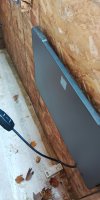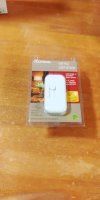Here's what I'm working on now,  It's been so warm, (hit 80 today) can't really get a good setting on each individual heat source. It's a new house for Thomas. Still have a lot to do with adjusting the heat source's. After getting everything set right I will straighten the wires. To heat this house I'm using 2 brooder heaters from Tractor Supply that max out at 200 watts each a 18x24 Stanfield heat mat that maxes out around 90 watts if I remember correctly and a 150 watt CHE. Each one is running through a lamp dimmer to adjust their heat output. I've never did a setup like this before so just in case I have an oil filled electric radiator heater on standby if needed. I know that the mat and the 2 brooders take more time to heat up, that's the reason for the CHE to bring the temperature up more quickly in case of an emergency. I've already tested that part and it worked fine. The control for the CHE is on the outside of the house all others are inside.
It's been so warm, (hit 80 today) can't really get a good setting on each individual heat source. It's a new house for Thomas. Still have a lot to do with adjusting the heat source's. After getting everything set right I will straighten the wires. To heat this house I'm using 2 brooder heaters from Tractor Supply that max out at 200 watts each a 18x24 Stanfield heat mat that maxes out around 90 watts if I remember correctly and a 150 watt CHE. Each one is running through a lamp dimmer to adjust their heat output. I've never did a setup like this before so just in case I have an oil filled electric radiator heater on standby if needed. I know that the mat and the 2 brooders take more time to heat up, that's the reason for the CHE to bring the temperature up more quickly in case of an emergency. I've already tested that part and it worked fine. The control for the CHE is on the outside of the house all others are inside. I'm putting vinyl siding on this house just for cosmetics.
I'm putting vinyl siding on this house just for cosmetics.
 It's been so warm, (hit 80 today) can't really get a good setting on each individual heat source. It's a new house for Thomas. Still have a lot to do with adjusting the heat source's. After getting everything set right I will straighten the wires. To heat this house I'm using 2 brooder heaters from Tractor Supply that max out at 200 watts each a 18x24 Stanfield heat mat that maxes out around 90 watts if I remember correctly and a 150 watt CHE. Each one is running through a lamp dimmer to adjust their heat output. I've never did a setup like this before so just in case I have an oil filled electric radiator heater on standby if needed. I know that the mat and the 2 brooders take more time to heat up, that's the reason for the CHE to bring the temperature up more quickly in case of an emergency. I've already tested that part and it worked fine. The control for the CHE is on the outside of the house all others are inside.
It's been so warm, (hit 80 today) can't really get a good setting on each individual heat source. It's a new house for Thomas. Still have a lot to do with adjusting the heat source's. After getting everything set right I will straighten the wires. To heat this house I'm using 2 brooder heaters from Tractor Supply that max out at 200 watts each a 18x24 Stanfield heat mat that maxes out around 90 watts if I remember correctly and a 150 watt CHE. Each one is running through a lamp dimmer to adjust their heat output. I've never did a setup like this before so just in case I have an oil filled electric radiator heater on standby if needed. I know that the mat and the 2 brooders take more time to heat up, that's the reason for the CHE to bring the temperature up more quickly in case of an emergency. I've already tested that part and it worked fine. The control for the CHE is on the outside of the house all others are inside. I'm putting vinyl siding on this house just for cosmetics.
I'm putting vinyl siding on this house just for cosmetics.
